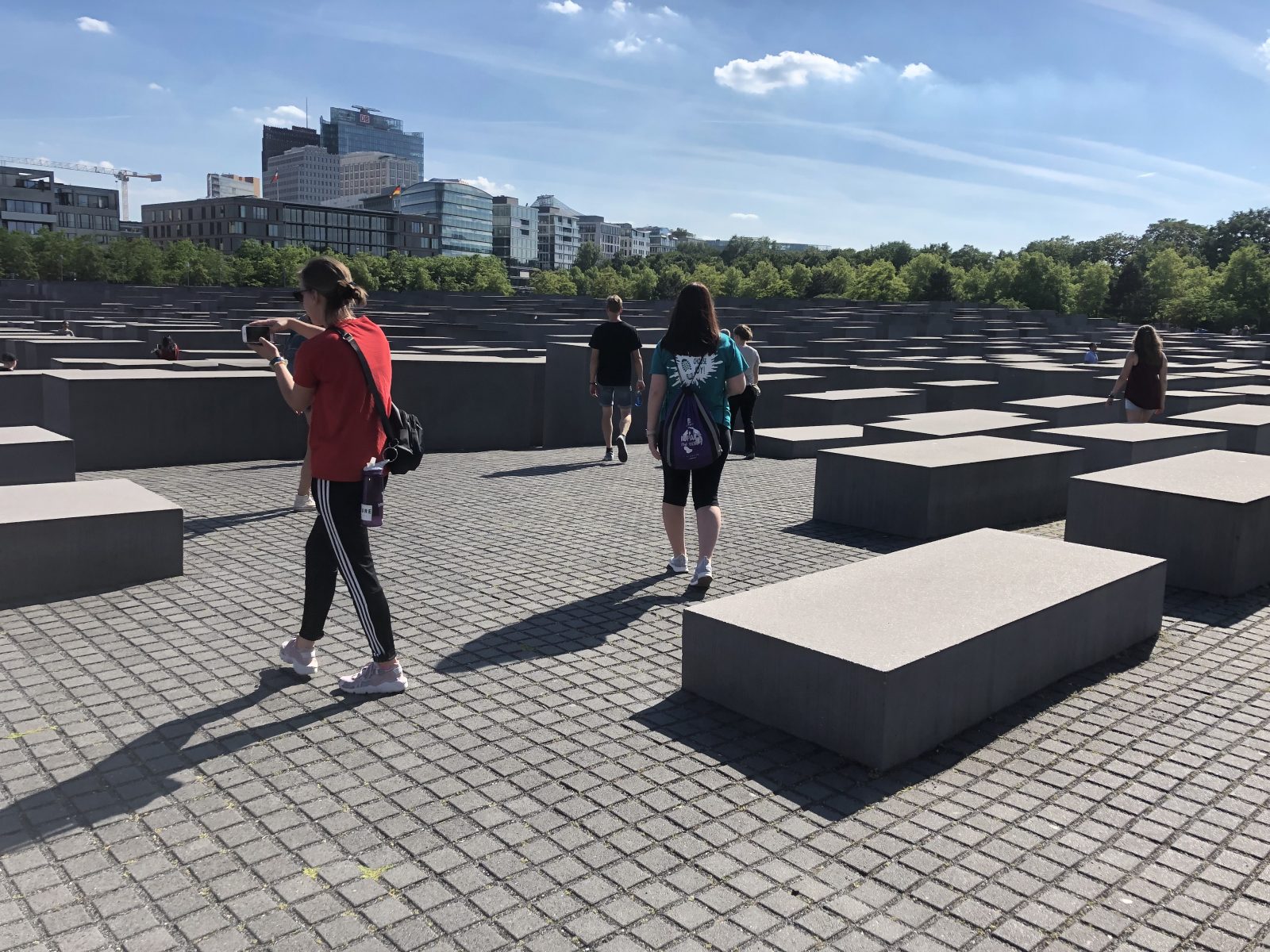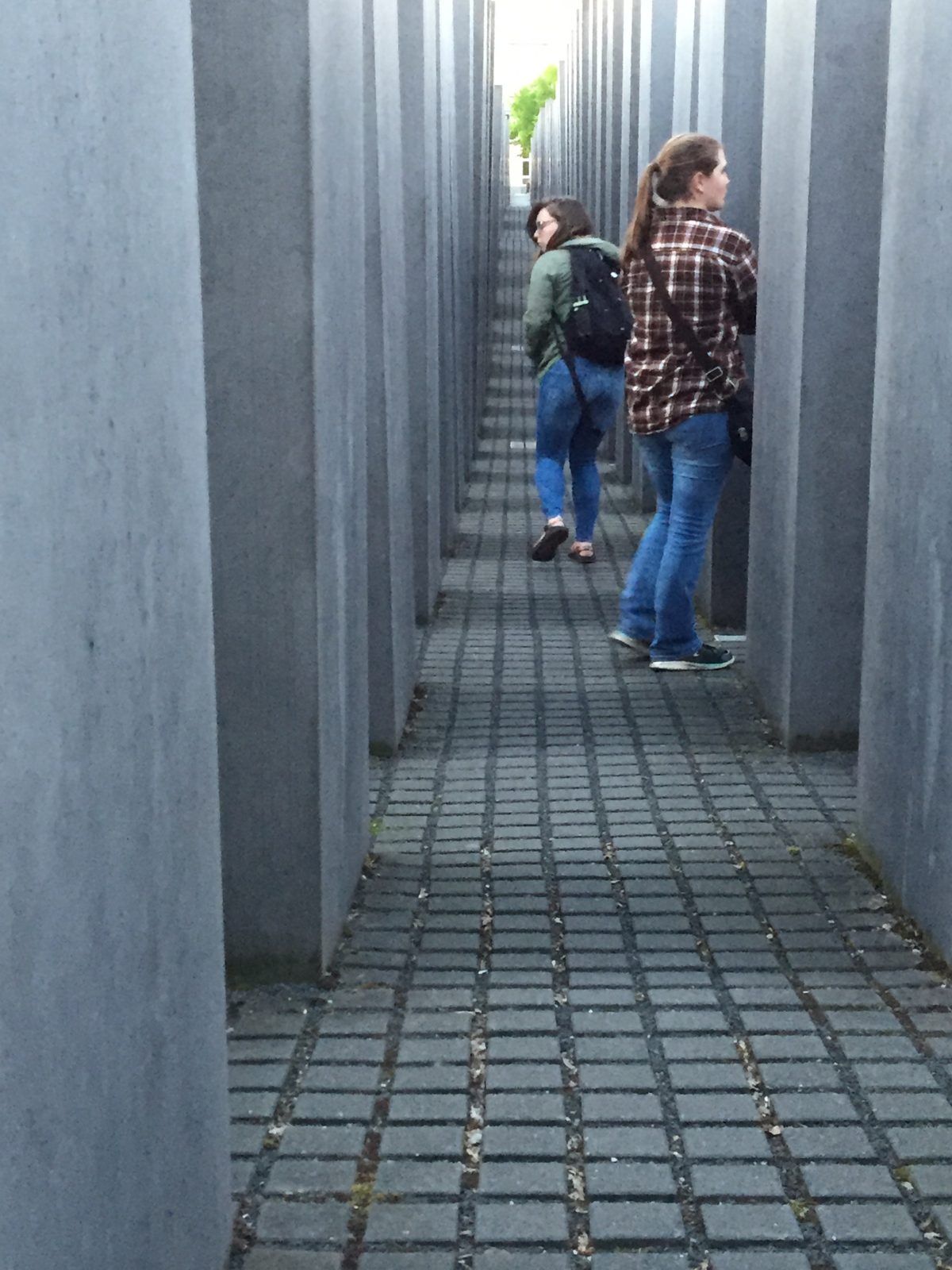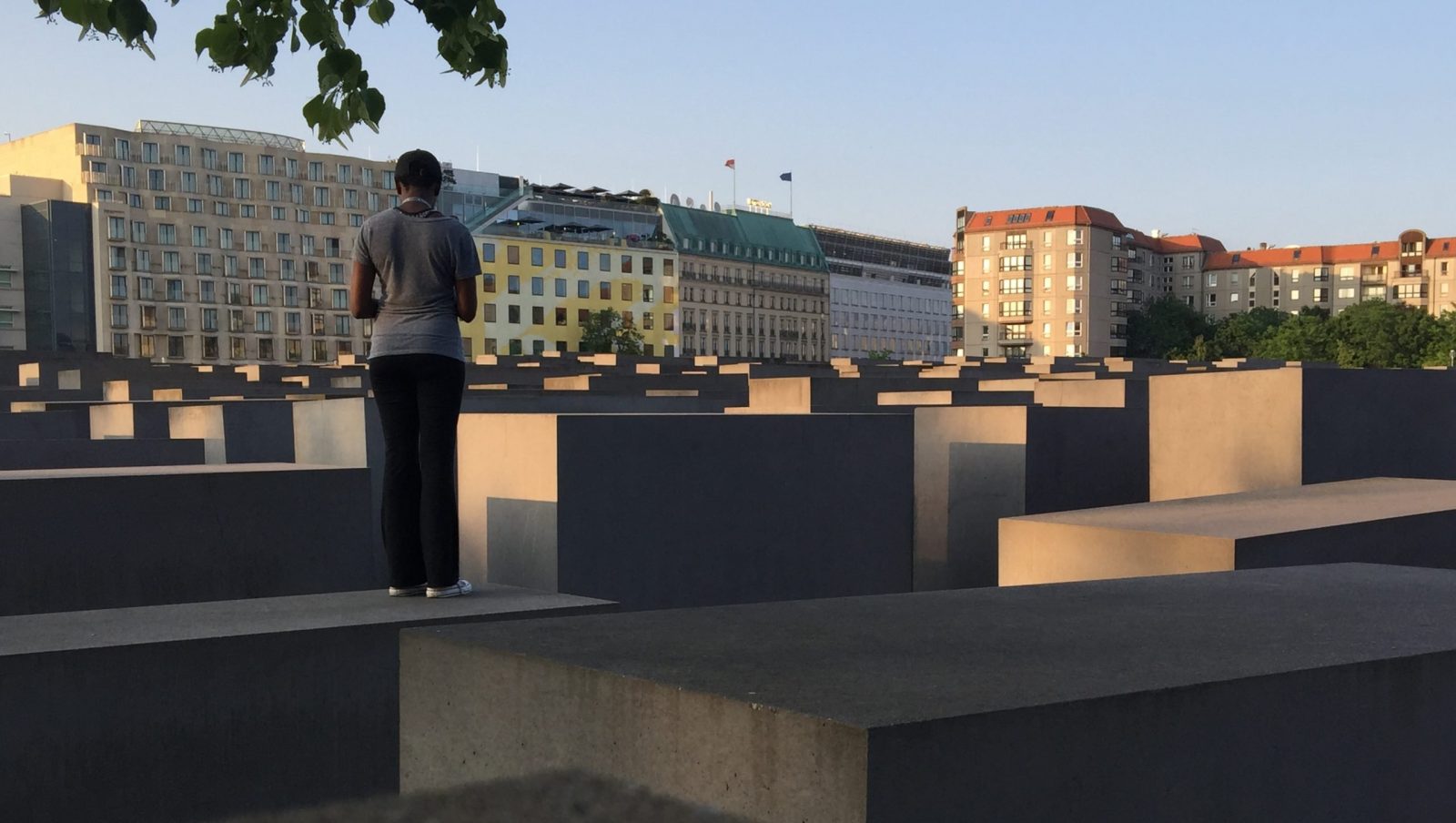
In Berlin, just one block south of the Brandenburg gate, sits a relatively new holocaust-related exhibit, the Memorial to the Murdered Jews of Europe. This installation, which opened in 2005, is massive, taking up an entire city block. Yet curiously, as one looks at it from the street, at no point does any part of the display rise above eye level. The exhibit consists of an assembly of over 2,700 rectangular concrete blocks, or stelae, ordered in grid-like rows and columns, spread across an area of 19,000 square meters. The blocks all measure the same in width and length with only the height varying, and each block being uniformly separated from neighboring blocks by about one yard. Visitors can effortlessly step from outside of the checkered field to within it at any point around the sidewalked circumference. Once inside, the height of the surrounding stelae slowly begin to change as one makes their way through the exhibit. This fluctuation, however, is hard to detect at any two adjoining steps. While the stelae gradually peak at slightly higher points, the ground on which one walks slowly slips lower and lower. The change is not constant. Rather, the terrain as well as the tops of the blocks wave slightly up and down as one moves through the display, but just like the motion of waves on a body wading further into the ocean, the deeper one goes into the display the greater one becomes enveloped by it. Like the proverbial frog in the frying pan, the visitor, without any significant cues, subtly moves from knee-high blocks around the perimeter to ones that reach heights exceeding 15 feet near the heart of the installation. Here, the blocks feel like towers and the passages between them seem to close in, the sky grows distant, the din of the street fades, and reference points slip away. One additional feature adds to the effect; the sections of concrete are each set ever-so-slightly askew to one another. The designers (Peter Eisenman and Buro Happold) intentionally introduced this thin form of asymmetry “to represent a supposedly ordered system that has lost touch with human reason.”1
Without noticing, what at first seems manageable and predictable on the periphery gently gives way to restriction, disorientation and, for some, a corresponding angst. The display captures well the broader story of the holocaust, pushing back hard against a narrative that wishes to explain this human horror as a mere momentarily loss of moral fiber wickedly engineered by a few terribly evil actors who somehow escaped detection and unleashed their hellish plan behind the back of an unsuspecting and innocent culture. Though obviously the full story does involve some spectacularly evil actors and key political decisions made at pivotal moments, what culminated in central Europe in the 1940’s is much more adequately represented by the numerous and seductively similar steps that mark the gentle undulations of the installation. The memorial captures well the gradual descent of the German culture, nursing a wounded sense of pride, as it slipped into moral bankruptcy.

Perhaps, however, the same assembly of unique physical features found in the memorial can also be used to bring to light a rarely examined assumption found in the intellectual imagination of Germany’s then leaders, an assumption that opened the door to the acts of dehumanization that so defined the holocaust. Allow me to explain. A fundamental feature of measurement theory is the distinction between the assessment of quantities and the assessment of qualities, or categories; that is, types of things. With just a moment’s reflection we can find good applications for both measurement styles in the vicinity of the memorial. Categorically, we can see distinct boundaries between various types of things; the surrounding roads, the sidewalk that circumscribes the memorial, the nearby office buildings, the city park across the street, and the memorial itself. Within the memorial, however, there are only two types of things, the stelae and the checkered ground on which they sit (see image to the left). The relationships amongst the blocks are best understood in terms of quantities. Some blocks are slightly shorter than their neighbors, while others slightly taller. So it is with the terrain; some areas gently slope upward while others softly give way. The world of stark qualitative differences between different types of things outside the memorial switches to a reality consisting of only slight quantitative distinctions between things within it.

Of course, both systems of measurement are helpful in gaining understanding, assuming the proper system is applied to a given situation. Quantitative measures offer meaning found in comparisons between similar things in terms of more, less, and absolute amounts. For instance, the age of an individual tells us if they are more or less aged than another and also provides us with a measure of how much time they have been alive. Categorical measures, however, reflect meaning marked by features, oftentimes features that reflect the essence of what a thing actually is. For example, to be categorized as pregnant, one must have a fertilized egg at some stage in development within one’s body. That is essential to being a member of the category “pregnant.” While someone may be somewhat old or somewhat young, or even somewhat in love, one cannot be somewhat pregnant.
A big question we have all been wrestling with since the 19th century is this: which of these two measurement systems captures best what it means to be human? Obviously, there are all sorts of differences between humans that can be measured quantitatively – and these quantity differences can be important and meaningful. But is there anything else? Is there a common essence that necessarily and categorically binds us all together as one type of thing? Against the political currents of the 1800’s that generally moved toward the recognition of a common human essence, came an argument from the emerging profession of science that pushed back against this trend; namely, Darwin’s understanding of the history of life. Many wrongly believe that the primary issue surrounding Darwin’s thesis concerned an understanding of history; namely, when did people come to be. As important as timelines are, the deeper issue is not about when. The much weightier topic is how humans came to be. Yet even at this point, we often miss the most critical claim being made by Darwin. As important as the issue of ex nihilo (out of nothing) versus an extended process is, the real crux of the matter concerns the issue of intent. Here, according to philosopher Alvin Plantinga (2011), is where the conflict really lies. Are humans ultimately the product of a mind that purposefully brought them about and gave them a particular essence or are humans just one among many unintended current life forms? Darwin’s most startling claim was that the how of human origins could be fully accounted for by only a what, a blind, pitiless, and cruel natural process, and completely excluding a who, acting with intention and for a purpose (that is to say, with a why).

This is important because if there is no who, then no matter how and when humans came to be, they were not intended, for intention entails agency; it requires a mind. In his second book, The Descent of Man (1871), Darwin makes his claim crystal clear; what are now called humans are just the current versions of a life form found on one particular branch of the tree of life. Rewind the clock and, given the contingencies of an exclusively undirected natural process, she will almost certainly not produce the same set of life forms again, including humans. Furthermore, we do not currently exist in some special frozen moment in time. As we move into the future, if life continues to persist, the planet will eventually be inhabited by a new set of creatures, and there is no guarantee that what we currently call humans will be among them. Humans have neither an essence that defines their “being” now nor one which protects them from “not being” in the future. Humans, like all other life forms, are constantly subject to the process of change. In fact, the label “human” is just a name we have given to this particular form of life at this particular time. Darwin moved humans out of a designed category marked with an essential nature and purpose and placed them into a system where nothing can ever be, in the end, essential. The claims of species categorization are just temporary labels. They do not correspond to any necessary structure infused into nature. All currently recognizable distinctions between types of things dissolve into collections of mere quantities, each set of which is subject to change in unplanned ways. Life, as Darwin imagined it, is a collection of free-floating biological forms bumbling along across an ever-changing ecological gradient that is constantly sifting out the unfit from the fit. Without intent it is very hard to argue for essence, and without essence there can be no meaningful categories, only collections of quantities, each one always subject to subtle change.
In his books, Darwin unfailingly describes the differences between humans and animal precursors in strictly quantitative terms. Over and over he suggests humans, in all our imagined glory, only differ from animals in terms of degree, not in terms of kind. What appears to be a unique human quality, upon closer inspection, has been achieved by the accumulation of an assembly of mere quantities.
This line of thinking served as the intellectual engine for what became known in the 19th and 20th century as scientific racism. It offered a new rationale, scientific in origin and terminology, for seeing differences between people as evidence of different positioning in a grand narrative of fluctuating progress, not unlike the assembly of stelae on the undulating terrain of the memorial. Sticking with the memorial as an analogy, instead of seeing a collection of different types of things each there for a purpose; the sidewalk, the streets, the neighboring buildings, a treed city park, and the memorial itself, the Nazis lost themselves in the category-free world found inside the memorial. Their world had shrunk to just the memorial itself. Here, the differences between blocks didn’t represent interesting and desired variability around a distinct and intended form (sitting in the midst of other distinct and intended forms outside the memorial). Rather, the quantitative differences between the blocks were seen as signifying meaning and direction for the future of the human form. This world was an unstable and changing one where the right kind of movement was key to progress and to owning the future. One could choose to act deliberately and intentionally move upward or act carelessly and likely slide down. It does not take much imagination to see how this line of thinking offered certain liberties regarding not only what was morally permissible, but actually what was good and right when it came to dealing with groups of people who were sitting on lower terrain and leading to downward directions. In that sort of world, the leaders of a once proud people, scrambling for self-preservation and eager to reclaim their deserved higher ground, knew exactly what needed to be done.
“Biological arguments for racism may have been common before 1859, but they increased by orders of magnitude following the acceptance of evolutionary theory.”
Stephen J. Gould, 1977 (Ontogeny and Phylogeny, p.127)
A few years ago, after I had given a conference presentation on the psychological obstacles to overcoming implicit racism, a student, somewhat smugly, remarked that these problems with human nature should not trouble Neo-Darwinists like himself, given that with time we are sure to see our nature change for the better just as it had undoubtedly done in the past. After all, everything is in progressive flux and the better, more adaptive qualities will surely emerge from the sifting and become commonplace with the next generation of beings. I did not want to embarrass the young man, but I felt like asking him if he believed some populations might be a little closer to this improved version of human nature than others? I also didn’t dare ask him if he had any ideas about how we might go about trying to nudge human nature along in this better direction. Without knowing it, he had beautifully demonstrated the logic of scientific racism; no essences, only flux and incremental progressive change.
So, back to our question. Is there something intentional and essential about humans that binds us all together? Or are we unintended and transitional beings where the differences between us indicate separate future directions for our progeny? Which line of thinking “… represent(s) a supposedly ordered system that has lost touch with human reason?” Without the concepts of intentionality and essence, which one is hard-pressed to find in an undesigned world, I do not see how one can remain intellectually consistent and yet hope to avoid that troublesome latter conclusion.

Darwin, C. (1871). The descent of man: And selection in relation to sex. London: John Murray.
1“Peter Eisenman about the Memorial”. Memorial to the Murdered Jews of Europe Foundation. Retrieved 26 February 2021.
Plantinga, A. (2011). Where the Conflict Really Lies: Science, Religion, and Naturalism. Oxford: Oxford University Press.